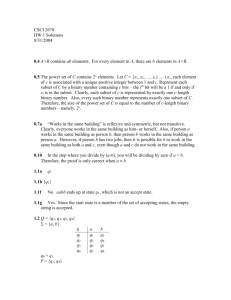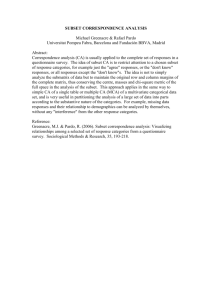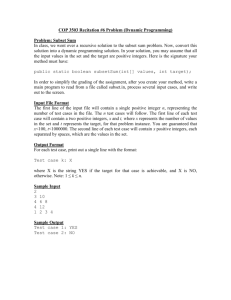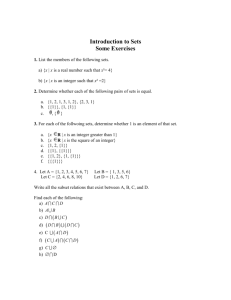Basics of Knowledge Discovery Engines
advertisement
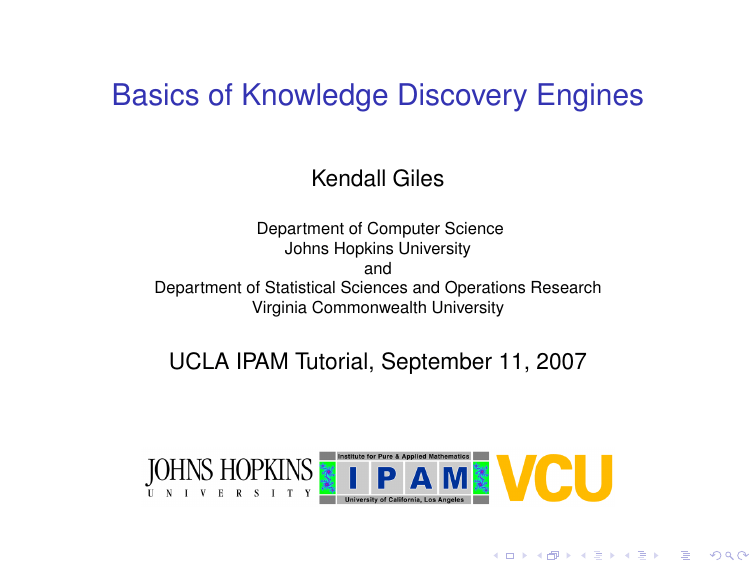
Basics of Knowledge Discovery Engines Kendall Giles Department of Computer Science Johns Hopkins University and Department of Statistical Sciences and Operations Research Virginia Commonwealth University UCLA IPAM Tutorial, September 11, 2007 Outline Motivations An Analyst’s Story The Ultimate Knowledge Discovery Algorithm Foundations Knowledge Discovery Process Knowledge Discovery Process Examples Knowledge Discovery System Example Science-News Example Outline Motivations An Analyst’s Story The Ultimate Knowledge Discovery Algorithm Foundations Knowledge Discovery Process Knowledge Discovery Process Examples Knowledge Discovery System Example Science-News Example What the Customer Wants A mysterious figure... who wants data turned into knowledge... What the Customer Wants A mysterious figure... who wants data turned into knowledge... What the Customer Wants A mysterious figure... who wants data turned into knowledge... What the Users Need Explorers of data... who need help with the deluge... What the Users Need Explorers of data... who need help with the deluge... What the Users Need Explorers of data... who need help with the deluge... Outline Motivations An Analyst’s Story The Ultimate Knowledge Discovery Algorithm Foundations Knowledge Discovery Process Knowledge Discovery Process Examples Knowledge Discovery System Example Science-News Example How to Solve Problems The Feynman Problem-Solving Algorithm: 1. write down the problem; 2. think very hard; 3. write down the answer. attributed to Murray Gell-Mann How to Solve Problems The Feynman Problem-Solving Algorithm: 1. write down the problem; 2. think very hard; 3. write down the answer. attributed to Murray Gell-Mann How to Solve Problems The Feynman Problem-Solving Algorithm: 1. write down the problem; 2. think very hard; 3. write down the answer. attributed to Murray Gell-Mann How to Solve Problems The Feynman Problem-Solving Algorithm: 1. write down the problem; 2. think very hard; 3. write down the answer. attributed to Murray Gell-Mann How to Discover Knowledge The Knowledge Discovery Algorithm: 1. collect some data; 2. look at it; 3. collect the knowledge. How to Discover Knowledge The Knowledge Discovery Algorithm: 1. collect some data; 2. look at it; 3. collect the knowledge. How to Discover Knowledge The Knowledge Discovery Algorithm: 1. collect some data; 2. look at it; 3. collect the knowledge. How to Discover Knowledge The Knowledge Discovery Algorithm: 1. collect some data; 2. look at it; 3. collect the knowledge. Outline Motivations An Analyst’s Story The Ultimate Knowledge Discovery Algorithm Foundations Knowledge Discovery Process Knowledge Discovery Process Examples Knowledge Discovery System Example Science-News Example What is Knowledge Discovery? 1 Goes by various names: I data mining I knowledge discovery I machine learning I pattern recognition I statistical learning What is Knowledge Discovery? 1 Goes by various names: I data mining I knowledge discovery I machine learning I pattern recognition I statistical learning What is Knowledge Discovery? 2 Is interdisciplinary: I computational statistics I machine learning I visualization I high-performance computing I data storage systems I algorithms I operations research I bioinformatics I information retrieval What is Knowledge Discovery? 2 Is interdisciplinary: I computational statistics I machine learning I visualization I high-performance computing I data storage systems I algorithms I operations research I bioinformatics I information retrieval What is Knowledge Discovery? 3 Can be defined as: the process of extracting previously unknown and potentially useful patterns inherent in data What is a pattern? an expression of some subset of the data or a model of the subset, or a high-level description of some subset of the data What is Knowledge Discovery? 3 Can be defined as: the process of extracting previously unknown and potentially useful patterns inherent in data What is a pattern? an expression of some subset of the data or a model of the subset, or a high-level description of some subset of the data What is Knowledge Discovery? 3 Can be defined as: the process of extracting previously unknown and potentially useful patterns inherent in data What is a pattern? an expression of some subset of the data or a model of the subset, or a high-level description of some subset of the data What is Knowledge Discovery? 3 Can be defined as: the process of extracting previously unknown and potentially useful patterns inherent in data What is a pattern? an expression of some subset of the data or a model of the subset, or a high-level description of some subset of the data What is Knowledge Discovery? 4 Note: clever algorithms are good, but clever algorithms that can be implemented for a user are even better classic tradoff between: speed, accuracy, cost What is Knowledge Discovery? 4 Note: clever algorithms are good, but clever algorithms that can be implemented for a user are even better classic tradoff between: speed, accuracy, cost What is Knowledge Discovery? 4 Note: clever algorithms are good, but clever algorithms that can be implemented for a user are even better classic tradoff between: speed, accuracy, cost What is Data? Object xi has q measurements: xi = (xi1 , xi2 , . . . , xiq )T ∈ R q I All n objects in the dataset can be expressed as an n × q data matrix. I known as vector-space model Examples: 1. Text Mining: n documents, q weights or scores for particular words or phrases 2. Image Analysis: n images, q pixel color or intensity values 3. Computer Network Traffic: n application or protocol flows, q network traffic counts or scores 4. DNA Expression Microarrays: n genes (nucleotide sequences), q cell samples What is Data? Object xi has q measurements: xi = (xi1 , xi2 , . . . , xiq )T ∈ R q I All n objects in the dataset can be expressed as an n × q data matrix. I known as vector-space model Examples: 1. Text Mining: n documents, q weights or scores for particular words or phrases 2. Image Analysis: n images, q pixel color or intensity values 3. Computer Network Traffic: n application or protocol flows, q network traffic counts or scores 4. DNA Expression Microarrays: n genes (nucleotide sequences), q cell samples Many (Statistical) Approaches class-conditional densities: I known I I Bayes Decision Theory unknown I supervised I I I parametric nonparametric unsupervised I I parametric nonparametric Example 1: Find SPAM supervised learning Example 1: Find SPAM supervised learning Example 2: Find EVIL-DOERS Enron Figure: The New York Times; Carey Priebe and Youngser Park, Johns Hopkins University unsupervised learning Example 2: Find EVIL-DOERS Enron Figure: The New York Times; Carey Priebe and Youngser Park, Johns Hopkins University unsupervised learning Method Components 1. model representation 2. model evaluation 3. parameter/model search Implementation Issues I large databases I distance I high dimensionality I overfitting I missing/noisy data I local patterns (as opposed to global patterns) I user involvement in the search Outline Motivations An Analyst’s Story The Ultimate Knowledge Discovery Algorithm Foundations Knowledge Discovery Process Knowledge Discovery Process Examples Knowledge Discovery System Example Science-News Example Process Figure: Fayyad, et al. Outline Motivations An Analyst’s Story The Ultimate Knowledge Discovery Algorithm Foundations Knowledge Discovery Process Knowledge Discovery Process Examples Knowledge Discovery System Example Science-News Example Iterative Denoising Methodology In a nutshell: Process a set of high-dimensional data; perform a local structure-preserving projection into a low-dimensional space; provide a visualization and interaction interface; partition and iteratively denoise. Motivated by: I Priebe, Marchette, Healy, 2004, "Integrated Sensing and Processing Decision Trees," IEEE PAMI. I Priebe, et al., 2004, "Iterative Denoising for Cross-Corpus Discovery," COMPSTAT. An Iterative Denoising Tree Iterative Denoising Framework Denoising Detail Laplacian Eigenmaps I nonlinear dimensionality reduction technique that distorts geometry in such a way that enhances some types of clustering I L = D - A is large, sparse I L is symmetric, positive semi-definite I 0 < λ1 ≤ λ2 ≤ · · · ≤ λd I corresponding d eigenvectors –> Fiedler Space I eigenvectors corresponding to two smallest non-zero eigenvalues –> visualization Outline Motivations An Analyst’s Story The Ultimate Knowledge Discovery Algorithm Foundations Knowledge Discovery Process Knowledge Discovery Process Examples Knowledge Discovery System Example Science-News Example A Science News Corpus A Clustering Hierarchy 1 1. 2. 3. 4. Anthropology Astronomy Behavioral Sciences Earth Sciences 5. 6. 7. 8. Life Sciences Math & CS Medicine Physics A Clustering Hierarchy 2 1. 2. 3. 4. Anthropology Astronomy Behavioral Sciences Earth Sciences 5. 6. 7. 8. Life Sciences Math & CS Medicine Physics Fiedler Space Projection 1 1. 2. 3. 4. Anthropology: yellow Astronomy: black Behavioral Sciences: magenta Earth Sciences: lightGray 5. 6. 7. 8. Life Sciences: orange Math & CS: red Medicine: green Physics: blue Fiedler Space Projection 2 1. 2. 3. 4. Anthropology: yellow Astronomy: black Behavioral Sciences: magenta Earth Sciences: lightGray 5. 6. 7. 8. Life Sciences: orange Math & CS: red Medicine: green Physics: blue Fiedler Space Projection 3 1. 2. 3. 4. Anthropology: yellow Astronomy: black Behavioral Sciences: magenta Earth Sciences: lightGray 5. 6. 7. 8. Life Sciences: orange Math & CS: red Medicine: green Physics: blue Fiedler Space Projection 4 1. 2. 3. 4. Anthropology: yellow Astronomy: black Behavioral Sciences: magenta Earth Sciences: lightGray 5. 6. 7. 8. Life Sciences: orange Math & CS: red Medicine: green Physics: blue Interesting Grouping 1. 2. 3. 4. Anthropology: yellow Astronomy: black Behavioral Sciences: magenta Earth Sciences: lightGray 5. 6. 7. 8. Life Sciences: orange Math & CS: red Medicine: green Physics: blue Thank you. Basics of Knowledge Discovery Engines Kendall Giles kgiles@cs.jhu.edu www.kendallgiles.com For Further Reading: K. Giles, M. Trosset, D. Marchette, C. Priebe. Iterative Denoising. Computational Statistics, Accepted for publication. 2007. U. Fayyad, G. Piatetsky-Shapiro, P. Smyth. From Data Mining to Knowledge Discovery in Databases. AI Magazine, 17:37–54, 1996. A. Jain, R. Duin, J. Mao. Statistical Pattern Recognition: A Review. IEEE Transactions on Pattern Analysis and Machine Intelligence, 22(1):4–37. 1998.



